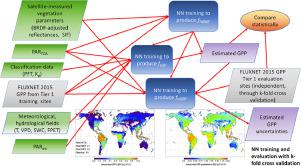当前位置:
X-MOL 学术
›
Agric. For. Meteorol.
›
论文详情
Our official English website, www.x-mol.net, welcomes your
feedback! (Note: you will need to create a separate account there.)
Satellite-based reflectances capture large fraction of variability in global gross primary production (GPP) at weekly time scales
Agricultural and Forest Meteorology ( IF 5.6 ) Pub Date : 2020-09-01 , DOI: 10.1016/j.agrformet.2020.108092 Joanna Joiner , Yasuko Yoshida
Agricultural and Forest Meteorology ( IF 5.6 ) Pub Date : 2020-09-01 , DOI: 10.1016/j.agrformet.2020.108092 Joanna Joiner , Yasuko Yoshida

|
Abstract A perception has emerged, based on several studies, that satellite-based reflectances are limited in terms of their ability to predict gross primary production (GPP) globally at weekly temporal scales. The basis for this inference is in part that reflectances, particularly expressed in the form of vegetation indices (VIs), convey information about potential rather than actual photosynthesis, and they are sensitive to non-green substances (e.g., soil, woody branches, and snow) as well as to chlorophyll. Previous works have suggested that processing and quality control of satellite-based reflectance data play an important role in their interpretation. In this study, we use high quality reflectance data from the MODerate-resolution Imaging Spectroradiometer (MODIS) data to train neural networks that are used to upscale GPP estimated from eddy covariance flux tower measurements globally. We quantify the ability of the machine learning approaches to capture GPP variability at daily to interannual time scales. Our results show that MODIS reflectances, when paired only with potential short-wave radiation, are able to capture a large fraction of GPP variability (approximately 77%) at daily to weekly time scales. Additional meteorological information (temperature, water vapor deficit, soil water content, ET, and incident radiation) captures only a few more percent of the GPP variability. The meteorological information is used most effectively when information about plant functional type and climate classification is included. We show that machine learning can be a useful tool for estimating GPP uncertainties as well as GPP itself from upscaling methods. Our estimated global annual mean GPP for 2007 is 142.5 ± 7.7 Pg C y − 1 , which is higher than some other satellite-based estimates but within the range of other reported observation-, model-, and hybrid-based values.
中文翻译:

基于卫星的反射率捕获了每周时间尺度全球初级生产总值 (GPP) 的大部分变化
摘要 根据几项研究,出现了一种看法,即基于卫星的反射率在每周时间尺度上预测全球初级生产总值 (GPP) 的能力有限。这一推论的部分依据是反射率,特别是以植被指数 (VI) 的形式表示,传达的是关于潜在光合作用而不是实际光合作用的信息,并且它们对非绿色物质(例如土壤、木质树枝和雪)以及叶绿素。以前的工作表明,基于卫星的反射率数据的处理和质量控制在其解释中起着重要作用。在这项研究中,我们使用来自中等分辨率成像光谱仪 (MODIS) 数据的高质量反射率数据来训练神经网络,这些神经网络用于升级根据全球涡流协方差通量塔测量估计的 GPP。我们量化了机器学习方法在每日到年际时间尺度上捕捉 GPP 变化的能力。我们的结果表明,当 MODIS 反射率仅与潜在的短波辐射配对时,能够在每天到每周的时间尺度上捕获大部分 GPP 变异性(约 77%)。其他气象信息(温度、水汽亏缺、土壤含水量、ET 和入射辐射)仅捕获 GPP 变异性的几个百分比。当包含有关植物功能类型和气候分类的信息时,气象信息的使用最为有效。我们表明,机器学习可以成为一种有用的工具,用于通过升级方法估计 GPP 不确定性以及 GPP 本身。我们估计的 2007 年全球年度平均 GPP 为 142.5 ± 7.7 Pg C y − 1 ,高于其他一些基于卫星的估计值,但在其他报告的基于观测、模型和混合的值的范围内。
更新日期:2020-09-01
中文翻译:

基于卫星的反射率捕获了每周时间尺度全球初级生产总值 (GPP) 的大部分变化
摘要 根据几项研究,出现了一种看法,即基于卫星的反射率在每周时间尺度上预测全球初级生产总值 (GPP) 的能力有限。这一推论的部分依据是反射率,特别是以植被指数 (VI) 的形式表示,传达的是关于潜在光合作用而不是实际光合作用的信息,并且它们对非绿色物质(例如土壤、木质树枝和雪)以及叶绿素。以前的工作表明,基于卫星的反射率数据的处理和质量控制在其解释中起着重要作用。在这项研究中,我们使用来自中等分辨率成像光谱仪 (MODIS) 数据的高质量反射率数据来训练神经网络,这些神经网络用于升级根据全球涡流协方差通量塔测量估计的 GPP。我们量化了机器学习方法在每日到年际时间尺度上捕捉 GPP 变化的能力。我们的结果表明,当 MODIS 反射率仅与潜在的短波辐射配对时,能够在每天到每周的时间尺度上捕获大部分 GPP 变异性(约 77%)。其他气象信息(温度、水汽亏缺、土壤含水量、ET 和入射辐射)仅捕获 GPP 变异性的几个百分比。当包含有关植物功能类型和气候分类的信息时,气象信息的使用最为有效。我们表明,机器学习可以成为一种有用的工具,用于通过升级方法估计 GPP 不确定性以及 GPP 本身。我们估计的 2007 年全球年度平均 GPP 为 142.5 ± 7.7 Pg C y − 1 ,高于其他一些基于卫星的估计值,但在其他报告的基于观测、模型和混合的值的范围内。











































 京公网安备 11010802027423号
京公网安备 11010802027423号